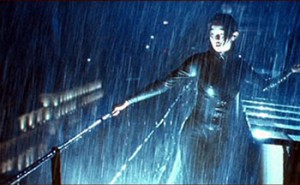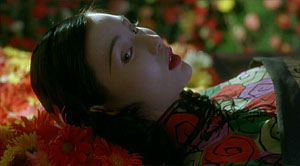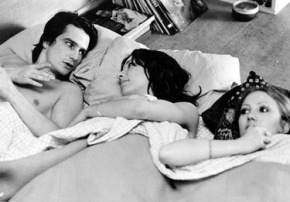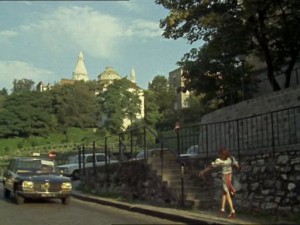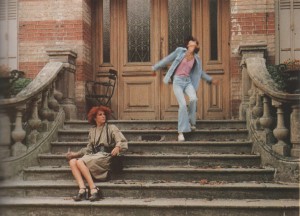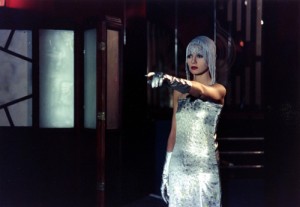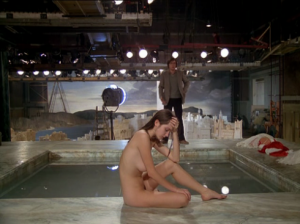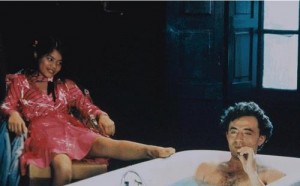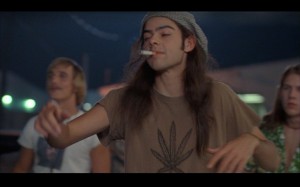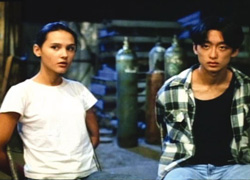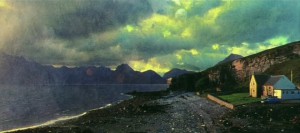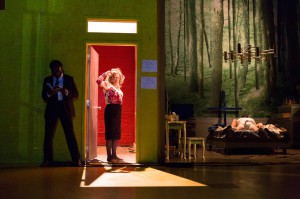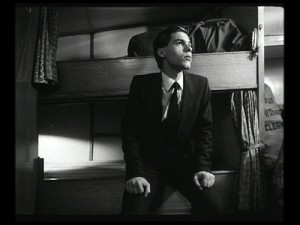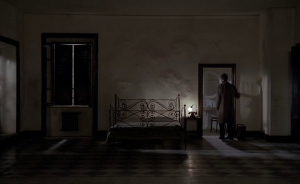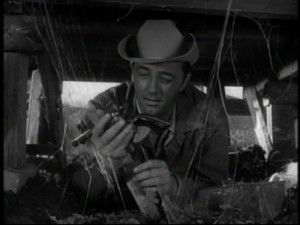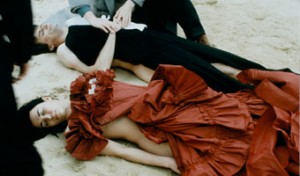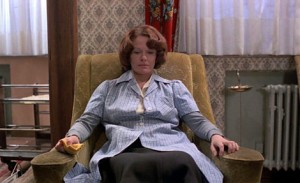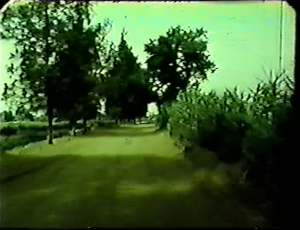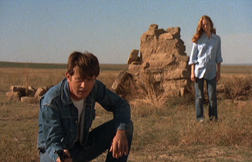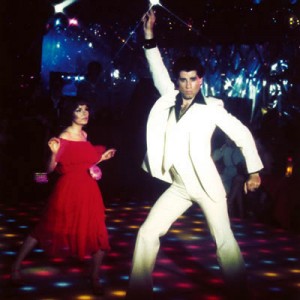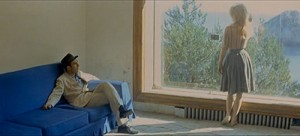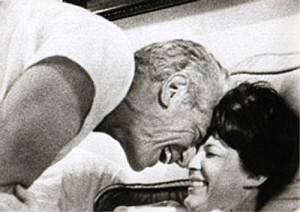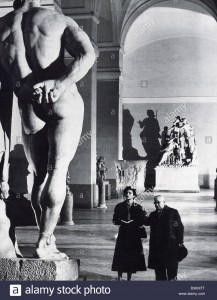These are the original letters published in French translation in Trafic no. 24, Winter 1997 and subsequently published in English in a 2003 book edited by Adrian Martin and myself, Movie Mutations: The Changing Face of World Cinephilia (London: British Film Institute). These letters have by now also appeared in Croatian, Dutch, Farsi, French, German, and Spanish. — J.R.
From Jonathan Rosenbaum (Chicago):
7 April, 1997
Dear Adrian,
Almost a year has passed since I wrote in Trafic* about “the taste of a particular generation of cinephiles — an international and mainly unconscious cabal (or, more precisely, confluence) of critics, teachers, and programmers, all of whom were born around 1960, have a particular passion for research (bibliographic as well as cinematic), and (here is what may be most distinctive about them) a fascination with the physicality of actors tied to a special interest in the films of John Cassavetes and Philippe Garrel (as well as Jacques Rivette and Maurice Pialat).” I named four members of this generation — Nicole Brenez (France), Alexander Horwath (Austria), Kent Jones (U.S.), and you (Australia). Each of you, I should add, I met independently of the other three, originally through correspondence (apart from Kent), although Kent and Alex already knew each other. By now, I’m happy to say, all four of you have become acquainted, either by letters or in person, which has opened up many possibilities of both testing my hypothesis and, even more, of extending, refining, qualifying, and better understanding it. I’ve noted, for example, other common enthusiasms among most or all of you, starting with Jean Eustache, Monte Hellman, and Abel Ferrara. And differences that usually relate to your (and my) separate nationalities: Kent and I are much cooler towards Brian De Palma than the rest of you, and Nicole is the only one among the five of us not excited by the recent work of Olivier Assayas.
The ironic thing about Nicole’s position is that, as you know, in my article for Trafic last year, I actually used a text by her as my launching pad for a discussion of Assayas’s Irma Vep. Let me quote from myself again (with a few slight revisions in the interests of clarity and accuracy): “One recent formulation of what I take to be this group’s taste can be found in Nicole Brenez’s article ‘L’acteur en citoyen affectif: Prenez garde à la sainte putain de Rainer Werner Fassbinder’ in Cinémathèque no. 9 (Spring 1996): ‘If Beware of a Holy Whore, despite certain common schemes and motifs, doesn’t form a link between Contempt and The State of Things, this is because it isn’t at root a reflexive film. Closer in this respect to Elle a passé tant d’heures sous les sunlights (Philippe Garrel, 1985), its subject isn’t the cinema but the body, its material isn’t the image but the actor, its problem isn’t representation but power.’ (my translation) It is this sentence especially that strikes a chord for me shortly after seeing Olivier Assayas’s Irma Vep — not only because the film itself suggests a multinational, bilingual companion piece to the films of Godard, Fassbinder, and Wenders, but also because, to paraphrase Brenez, its subject is not so much the cinema but the body of Maggie Cheung, its material is not so much the image but Maggie Cheung herself, and its problem is not so much representation but the power that rises, falls, and circulates in relation to the figure and figuration of Maggie Cheung.
“This leads to an interesting paradox- – that even though Irma Vep invites and suggests many cinematic cross-references (not merely those already mentioned, but also, most obviously, Feuillade’s Les Vampires, and, in the figures of the directors played by Jean-Pierre Léaud and Lou Castel, Rivette and Godard, among others), its subject is less ‘cinema’ as a pure substance than cinema as a battleground, a treacherous terrain where power struggles are being constantly waged. A few of these struggles, like those in Contempt and The State of Things, are between the discourses of business and art — most notably and hilariously here in the interview Cheung gives to an aggressive French journalist eager to impose the commercial values of a John Woo or a Jackie Chan over the values of an art cinema represented by René Vidal (Léaud), and all but oblivious to the objections of Cheung. But most of the struggles, such as those between the crew members Maite (Dominique Faysse) and Zoe (Nathalie Richard) over the possession of Cheung, are, like those of Fassbinder, parodies of art-making and business carried out on the fringes of both activities and given a rather abstract status in relation to the film that is being made.
“And when it comes to the film that is being made — the hypothetical Irma Vep of Vidal as opposed to the Irma Vep of Assayas — what we see is far more mysterious, at best two extended pieces of evidence that remain profoundly nonconclusive. Assayas offers us two radically different versions of this hypothetical film that together form a potent dialectic — the first (apparently) propelled by Cheung, the second (apparently) propelled by Vidal — but the fact that neither sequence makes a comfortable or plausible ‘fit’ in its assigned place within the narrative is central to the beauty and mystery of both interludes. (This lack of a precise ‘fit’ recalls the pre-credits sequence in Cassavetes’s Faces, when John Marley joins several business associates at a private screening of a film that we never see; in both cases, we experience a rupture in both the narrative and the style that is never accounted for, as if the film were passing without warning between parallel universes.)
“In the first of these sequences, Cheung in squeaky black rubber tights (her Irma Vep costume) is seen emerging one night from her hotel room. Following a maid, she sneaks into another room where a nude woman (Arsinée Khanjian) is speaking fretfully on the phone, long-distance, to her husband or lover about her boredom and isolation, and steals this nude woman’s jewels. (Because Khanjian is an isolated foreigner in Paris speaking English, she functions in a way as Cheung’s Doppelgänger, fully naked just as Cheung is always fully clothed in the film.) Then Cheung runs outside onto the roof in the rain, examines the jewels, climbs higher, and then tosses the jewels over a ledge. In the second of these sequences, the last in the film, we see a version of the dailies edited the night before by Vidal, shortly before he had a nervous collapse and decided to abandon the film in midstream; Cheung again appears in her black tights, but this time there is no coherent narrative and a great deal of graphic writing on the images that highlights or embellishes certain visual details.
“What do these two sequences consist of? Two possible ways of ‘remaking’ Les Vampires in the 1990s — the first strictly commercial, the second strictly experimental, neither of which seems to be the approach of Vidal (which apparently exists somewhere between these possibilities). In both cases, they seem to belong not to the narrative of Assayas’s film but rather to a dream dreamt by that narrative — suggesting that Irma Vep is a film about the unconscious to the same degree that Les Vampires (or Rivette’s Duelle or Noroît is, a kind of automatic writing. (The script, Assayas notes, was written in only ten days.) Perhaps the ambiguity of the relationship between these sequences and the remainder of the film is that they exist in separate channels rather than on separate levels; acoustical metaphors seem more relevant than visual ones.
“In this respect, these two sequences differ appreciably from the scene in which Cheung rehearses with one of Vidal’s assistants and pantomimes fear — a sequence that for me recalls Cheung’s lovely performance as the silent Shanghai film actress Ruan Ling-yu in Stanley Kwan’s masterpiece Actress, and therefore, with the apparent rationality of a cinematic cross-reference, proposes a relatively rational response to the question, ‘What might a 1996 version of Les Vampires consist of?’ The other two sequences propose relatively irrational responses to the same question: if we called the first Franju-like or the second Brakhage-like, we’d merely sound like idiots stuck for an explanation; neither adjective would clarify the function of either sequence in the film as a whole. In terms of this function, perhaps my reference to the opening of Faces is more helpful, but at best this can only serve as a loose analogy. The real work of analysis might start from such a comparison, but it could never end there. . . .”
What fascinates me most of all about the “confluence” I was discussing earlier (Nicole objects to “cabal” for what she perceives as its right-wing connotations) is how it came into being. After all, the main message someone of my generation (born in 1943) hears almost daily is that cinephilia as we once knew it is dying — the cinephilia, that is, that took root in the New Wave around the same time that you four were born. In the mainstream American press especially, articles by (among others) Susan Sontag, David Thomson, and David Denby about the “death” of cinema and/or cinephilia have become common currency — a position which of course becomes easier to take in a country where not a single film by Hou Hsiao-hsien, Edward Yang, Abbas Kiarostami, or Mohsen Makhmalbaf has yet been properly distributed, and where the most important European and (in some cases) American features (such as Dead Man and Thieves) are usually acknowledged only in the alternative or “underground” press.
Though clearly my own tastes are not the same as yours, I still feel that your generation may be the first to have emerged since the 70s that is in rebellion against the amnesia regarding both film and criticism that affects nearly everyone else — which is why it seems relatively easy for me to communicate with all of you. I’m reminded of a beautiful novel of 1936 by my favorite science-fiction writer, Olaf Stapledon, Odd John, about a group of superhuman mutants scattered across the world who gradually come to know one another — in secret, of course, because an open acknowledgement of their special talents would frighten most people and threaten existing institutions.
What seems “dangerous” to me about your collective sensibility (if I can describe it as such) is a familiarity with the paradigms and master theories of the past combined with a willingness to update and alter them according to current needs. For much too long, spectators of my and Sontag’s generations have been arguing that if you weren’t around in the 60s when Godard, Antonioni, and others were changing the face of cinema, then you can’t be expected to understand what’s lost or missing today. But I would counter that if you don’t understand what morphing is and does — what the alteration of a pixel does to an on-screen event — than you can’t be expected to understand the contemporary relevance (or irrelevance) of Bazin’s theories about the plan-sequence and deep focus. Moreover, if you fail to understand the changing face of film commerce since the era of Bazin — a subject involving such disparate matters as state funding, corporate ownership, video, and publicity — you don’t stand much chance of perceiving contemporary film aesthetics and the formation of canons.
So much for the need for new paradigms and theoretical models. But what were the specific needs of your generation that gave rise to your particular brand of cinephila? As you indicated when we discussed this in Melbourne last year, the specific lure of minimalism as evidenced in films by Garrel and Akerman and by The Mother and the Whore was a historical response to a certain surfeit of intertextual reference that grew out of the New Wave — the sense that every text was to some extent an anthology of cross-references to previous texts, a palimpsest of film history that beyond a certain point became so encoded in its own textual processes that a certain simplification of concerns and affects became desirable. And, as you pointed out, this simplification appeared in different forms: Cassavetes, by stepping outside the usual process of contextuality, was injecting a new version of raw life and lived experience into the cinema, and so in a different way was Garrel. Akerman, whose minimalism derived in part from painting, was clearing away the cobwebs in a different if related fashion, and Hellman, who may have taken some of his cues from the theater of Beckett, had his own ways of draining away outdated significations. The process can perhaps be seen most clearly in The Mother and the Whore, where Eustache was deliberately taking some of the most cherished emblems of the New Wave — Jean-Pierre Léaud, extended dialogues in Left Bank cafés, literary aphorisms, black-and-white cinematography — and showing in his disillusionment how some of that era’s utopian notions of love and freedom could no longer be supported or sustained; how, in fact, they had become a certain camouflage and holding action for blocking despair. (The fact that this also implied a certain defeatism and conservatism, where Catholic bourgeois “necessity” implicitly becomes a kind of biological truth — above all in Françoise Lebrun’s tearful extended monologue — was for me the limiting factor in this enterprise.)
An even clearer illustration of what was happening to cinema during this period can be traced though the career of Rivette in the early 70s. Two separate versions of the same threshold are crossed — the first roughly halfway through Out 1 (in both its versions), the second between Celine and Julie Go Boating and Duelle. I realize that you haven’t been able to see these pictures apart from Celine and Julie –– such are the vagaries of Australian distribution, not to mention distribution of Rivette’s work in general — so I hope you can bear with my somewhat abstract interpretation of what took place, which in each case involved an emptying-out of meaning. It’s a process that Barthes spoke about with Rivette and Michel Delahaye many years before (in Cahiers du cinéma no. 147, September 1963): “The best films (to me) are those which best withhold meaning. To suspend meaning is an extremely difficult task requiring at the same time a very great technique and total intellectual loyalty.” (Translated by Linda Coverdale in Barthes’ The Grain of the Voice: Interviews 1962-1980, New York: Hill and Wang, 1985, p. 21.)
Barthes’s model for this delicate operation was Buñuel’s The Exterminating Angel. But it seems to me that an even clearer illustration can be found almost a decade later in the master narrative of Out 1, which begins by accumulating all sorts of meanings — meanings related to conspiracy, to theater, to all sorts of human interactions and exchanges (including implicitly the accumulation of meanings that clustered around such dreams as those of the New Wave, those of the counterculture, and those of May ‘68 — in short, utopian 60s dreams of collective effort) — and then remorselessly records the draining away of those meanings and connections, the gradual splintering of the very idea of collectivity into solitude, unsolvable puzzles, paranoia, madness. Perhaps it’s just another version of the dialectic Rivette (like many other filmmakers) experiences between the collective adventure of shooting followed by the more solitary activity of editing, but in this case it provides a mythical and formal model for the artistic and political Zeitgeist of the 60s and 70s themselves, at least in that particular corner of the world.
A related threshold is crossed between Celine and Julie Go Boating and Duelle. The first of these features represents to my mind a final flowering (or is it last gasp?) of the referential aspect of the New Wave, the aspect where Rivette’s previous career as a film critic is most apparent — an explosion of references to Hollywood musicals, Feuillade serials, Hitchcock thrillers, other films of the New Wave, and so on. All these references are allowed to interact with and enhance particular locations, actresses and actors, everyday moods and details. But in Duelle, which may have just as many references to other films (especially Hollywood noirs like The Seventh Victim, The Big Sleep, The Lady from Shanghai, and Kiss Me Deadly, but also fantasies by Cocteau and Franju), the references no longer connect with material reality in the same manner. The world of the characters seems congealed, under glass, disconnected from the natural locations and to some extent from the actresses and actors as well — a private and more obsessive world populated by the bodies of actors more than their faces or souls.
This, at any rate, is one version of what happened between the New Wave and its aftermath — the version of someone 17 years older than you who tends to see the New Wave as a kind of nostalgic family homestead that has been levelled for the erection of a high rise. But there are other and I’m sure more fruitful ways of viewing this evolution, and I would be eager to hear yours.
Your pal,
Jonathan
*“Comparaisons à Cannes,” Trafic no. 19, Summer 1996, p. 11.
© Jonathan Rosenbaum 1997
From Adrian Martin (Melbourne):
30 June, 1997
Dear Jonathan & Kent,
Although I am technically — it is true — a “child of the 60s” (born 16 September, 1959, the day after Godard completed shooting A bout de souffle), I don’t have the same “magical” relation to the cinema of that epoch that Jonathan and others of his generation have. As a child who grew up in the 60s — which is a rather more mundane way of putting the situation — my most intense memory of 60s cinema as it unfolded was dreaming in perfect clarity and detail, when I was seven years old, several scenes from The Planet of The Apes several months before I knew the film even existed.
Actually, these days, my relation to the 60s finds its precise image in the dream or myth of that decade which I believe animates Irma Vep: a whirlpool of cultural traces, Franju and Gainsbourg and Marker and the New Wave, pulled through some foggy filter of longing and fascination into our confused and desperate present day. As for the tastes that align me with my brothers and sister in this “cabal” we have going here, I can more truthfully trace that moment of rupture and self-identification to a specific stage of the 1970s. It is the time of high film theory in full flight and force: Althusser, Lacan, Metz’s film semiotics, Stephen Heath and the British mob at Screen magazine, the feminist analyses in the first issues of Camera Obscura in America, Wollen & Mulvey’s “new talkies” or “essay films” dutifully read (and taught) through the template of theory. Plus the various Australian outposts of this loose, broad but powerfully influential “movement.” I remember this as the era of hard words, of viciously exclusionary intellectual sects, of the “necessary destruction of pleasure” and neo-puritanism, of “political correctness” before its time and “anti-humanism,” of “signs and meanings,” interpretative grids, and avant-garde holy grails.
If I caricature this movement now for the purposes of shorthand, I lampooned it even more wildly back then through the sheer force of my angry, peeved passion. The 70s, at least within this circuit that I had to endure in the universities, was not the time or place for a starstruck, “buffish” cinephile like myself. Nor was it a time for any kind of poetry or lyricism or even simple fun in cinema or its critical writing; there was programmatic work to be done. When I was young and impressionable, I too wrote briefly under the sway of the “march of theory,” until the day that a wise, kindly friend said to me, “Adrian, why don’t you write your articles the way you write your letters?” And that is, in a sense, what I have tried to write ever since: love letters to the cinema, if we remember to include in our working definition of love every kind of passion and need and exasperation and exacting, critical demand.
I like the way that Nicole Brenez’s survey “The Absolute Voyage: Remarks on Contemporary Film Theories” politely sidesteps this whole nasty legacy of the 70s and starts its story with the freer, more creative intellectual moves of the 80s: for her, that means Deleuze, Daney, Schefer . . . and also certain golden oldies skillfully excavated, reread, translated, and inserted into the present tense, like Vachel Lindsay. In my part of the world, I felt the need to trace a similar kind of loop: to join Farber, Durgnat, and others from the past to exemplary voyagers of the present like Bill Routt and Stanley Cavell.
But it was cinema itself that really led the way for me in the early to mid 80s. It is hard to recapture, to describe adequately, the overwhelming shock that came with key movie events of that time like Marker’s Sunless, Wenders’ The State of Things, Godard’s Passion, Akerman’s Toute une nuit, and Ruiz’s Hypothesis of the Stolen Painting. Suddenly here were the films playing right outside the maps of 70s theory: free, lyrical, tender, poetic films, but also tough, savage, cruel, perverse, sometimes violent; films that were open diagrams, unashamed to link up raw fragments of human (‘humanist’) experience with the most severe or expansive kinds of experiments with form. These discoveries got drawn into a rich historical loop, too: suddenly I and my friends were seeing afresh the films of Vigo, Humphrey Jennings, and especially that unique pre-New Wave figure, Jean Rouch.
Later, my love for an open cinema, for the ideal of a truly open, inclusive, and above all ‘impure’ cinema form, came to be crystalized in my personal discoveries of Cassavetes and Garrel — the single screenings in my home town of Melbourne of Love Streams (in 1985) and Les Baisers de secours (in 1994) count as primal scenes in my cinephile life. Cassavetes and Garrel stand for one sort of extreme that I love and cherish in cinema: a kind of arte povera fixed on the minute fluctuations of intimate life, on the effervescence of mood and emotion, and the instability of all lived meaning. A cinema which is a kind of documentary event where the energies of bodily performance, of gesture and utterance and movement, collide willy-nilly, in ways not always foreseen or proscribed, with the dynamic, formal, figurative work of shooting, framing, cutting, sound recording. A cinema open to the energies and intensities of life — and perpetually transformed by them.
I have always sought such life-affirming, life-enhancing energies and intensities from cinema. But I am aware that the energies that I like, the energies which feed me, do not come in just one form, from one stream. The arte povera of Cassavetes and Garrel gives me a quiet, clear, minimalist intensity. But I get a different kind of energy, no less necessary for my soul’s survival, from a completely commercial kind of cinema, a ‘cinema of spectacle’ decried by so many of even a slightly Situationist bent, still today. I mean a kind of ‘pop cinema’ that includes De Palma’s Mission: Impossible, Tim Burton’s movies, Dante’s Gremlins 2 — a kinetic, sometimes cartoonish, extremely artificial and technologically ‘mutated’ movies with no small claim on the cinematic language of tomorrow. I have cultivated my own particular, somewhat ‘minor’ taste within the halls of contemporary pop cinema — a taste for ‘teen movies’, from Ferris Bueller’s Day Off to Romy and Michele’s High School Reunion, films completely comprised of pop quotes, clichés and stereotypes, but blessed with the will and the inventiveness to ‘animate’ these tokens, to combine and revive and spin them at a dizzy rate.
Jonathan speaks of how the cinema povera beloved of us 60s kids comes in as some kind of reaction or corrective to a New Wave legacy oversaturated with filmic and cultural references. But the intimate, minimalist cinema I cherish is really only an interregnum, or an interstice, within a filmic history that refinds its referential, self-reflexive, quotational bent with a vengeance in the ‘postmodern’ age — which also begins, I believe, in the early 80s. All the proliferating genres and subgenres of pop cinema are part of this movement, as are certain po-mo blockbusters like Brazil and Blade Runner, and also seminal po-mo art movies about identities-as-simulacra-in-a-crazy-mixed-up-world, beginning with Paris, Texas and Diva. Certain important directors of today — such as Assayas and Leos Carax — find their rich, distinctive, hybrid forms by crossing elements of the ‘energetic’ American style (the style of Coppola or Scorsese) with miniaturist and minimalist elements from Garrel or Hellman.
I think that I am some kind of product of what was named in the late 70s the “new cinephilia.” Actually, the first worries about a new cinephilia were expressed as far back as the mid 1960s — when youngsters started seeing the great works of cinema for the first (and sometimes only) time on TV rather than cinema screens. But the new cinephilia really gets going with the age of home video — yet another thing that emerged in the early to mid 80s. Video consumption completely altered the character of film cultures all over the globe. Suddenly, there were self-cultivated specialists everywhere in previously ‘elite’ areas like B-cinema, exploitation cinema, and so-called ‘cult’ cinema (and also, of course, a thousand and one campaigns aimed at engineering and guiding such ‘niche market’ tastes).
Where I live, directors including Abel Ferrara, Larry Cohen, and even far-left-fielders like the forgotten erotomaniac Walerian Borowczyk, figure as “video shop directors,” to be ferreted out and perpetually rediscovered by termite-like connoisseurs. ‘Video buff’ culture can sometimes be a strange, nerdish, exasperating, and disappointingly limited thing, but I don’t think it is a bad thing — because it has opened up new intensities, new streams for the circulation and appreciation of cinema. And this is particularly valuable in an age where — certainly in Australia — the once sacred (and often inspiring) ideal of ‘art cinema’ has degenerated into the very limited access to world cinema provided by the commercial ‘art house’ circuit.
So all we need now is a way of rescuing artists like Ruiz, de Oliveira, Béla Tarr, and so many other ‘limit’ cases from the oblivion to which they have been cast by these merciless art houses, a way of rescuing and then feeding them into the vast, chaotic, and slightly democratic video markets whose aficionados only need to stretch their working definition of what is weird and wonderful in cinema. Because what is democratic in this video culture is the precisely the capacity (or at least the potential) to suspend normative judgements about cinema — reminding me of one of my all-time favourite critical mottos, the attitude attributed by Louis Seguin to Ado Kyrou of seeking “surprise rather than satisfaction” and preferring “discovery to certainty.”
My own decidedly double taste in cinema leads me into the contemplation of several paradoxes. For instance: the films of Garrel and Cassavetes herald some kind of primal, fundamental return to the body: to the body as the only remaining site of authenticity, of lived and verifiable experience, of sensation and desire. This has led filmmakers, and film writers, into many eulogies on the flesh, the face, the mortal and vulnerable body fixed within the painfully perishable medium of celluloid. . . . Yet the cinema of high technological artifice, of special effects, digitalization, and morphing, leads us to contemplate a radically different kind of cinematic body, a body created in and for cinema: the completely synthetic, prosthetic, ‘retouched’ body, the body of action or horror, the hyper-sensate, super-tensile, immortal, and imperishable body. As the Australian cultural theorist Philip Brophy puts it, all cinema’s bodies are at some level ‘pornographs’ — bodies wholly mapped, graphed, by the artifices of the medium — and so all pop blockbusters are (and let us say this without the usual moral condemnation) our mad, delirious, modern pornography.
There is a recourse to the high moral ground — and to a certain lamentable ‘purism’ — in a lot of film criticism today, even some of the most advanced. We read or hear far too often that there are only half a dozen directors working today who fulfill — or might one day fulfill, if we’re all lucky — the potential, the promise of this dazzling medium. We keep getting familiar-looking canons of the greatest Top 100 titles worth preserving, even as we pretend to have gotten beyond all canons, hierarchies, and evaluations. We keep looking for the authentic personal voice in film, the true lone poet, the accursed seer and the discarded rebel, decades after the movies let us know that even the sleaziest, most ideologically compromised fantasies of Blake Edwards are also — and who can doubt it? — beautiful, moving, lucidly autobiographical testaments.
As heretical as it sounds — even within this very cabal — I like the sentiment of Deleuze’s casual prefatory remark in Cinema 2: The Time-Image: “The cinema is always as perfect as it can be.” Meaning that its potentiality, its ‘virtuality’ is, in some way, right here now — if we know where to look for it, how to maximize it, why it matters, and how to make it dance, for us and in us, like Rouch’s privileged, shamanic figure of the “dancing Socrates.”
Your pal,
Adrian
© Adrian Martin 1997
From Kent Jones (New York):
7 July, 1997
Dear Alex, Adrian, and Jonathan,
The other day I remembered that the first time Alex and I met we were “paired up” by a mutual friend who is about 20 years our senior. Her intuition was correct since we are now close friends, but clearly she had us both pegged as younger members of that allegedly extinct species, the cinephile. Now we’ve been called upon by another older mutual friend to define our cinephilia. Jonathan is fascinated not by what he shares with Alex, Nicole, Adrian, and myself, but rather by what separates him from us: he wants to understand our generation’s particular permutation of cinephilia. I think that he was genuinely surprised when he realized that we all existed, spread across three continents and possessing somewhat similar tastes and, more importantly, very similar preoccupations. He was heartened to know that the object called cinema, to which he has devoted his life, has continued to inspire devotion in people younger than himself. Because for many of Jonathan’s generation, cinephilia is as much a thing of the past as the LP or the dial telephone, an enthusiasm from their fervent and passionate youth that is now gone, spoiled by television and video (and in America, as Jonathan points out, by the demise of independently owned theaters). But as a devotee of Pynchon, Rivette, and Stapledon, Jonathan knows all about practices and rituals carried on in secret, long past the moment when their spark of origin has burned itself out.
As much as I resent the mournful pronouncements of the demise of cinephilia and the impending death of cinema from Sontag, Thomson, and even Godard, all so full of barely concealed anger, I sympathize with that anger. From 1982 to 1984 I worked in one of the first video stores in Manhattan, and I will never forget the shock I felt when a customer asked me for “something big and plush that I can really sink into, like the Godfather movies.” That was when I realized that home video was opening up a new form of film appreciation antithetical to any I had ever seen, in which each film was potentially a self-prescriptive therapeutic device. And this was only possible because home video had made each film into a portable consumer object that could be stopped, started, reversed, repeated, or abandoned at will. And as horrified as I was, I knew that I had to come to terms with what amounted to a whole new world, the beginnings of the world we live in today.
It’s interesting that in Sontag’s death of cinephilia tirade, Quentin Tarantino becomes what is now quaintly referred to as a structuring absence: obviously, the problem for her is not so much that he’s not a cinephile but rather that he’s the wrong kind of cinephile. Tarantino’s background as a video-store clerk has now become a joke, and I’m afraid that the joke is a snide, snobbish one (when I told an acid-tongued friend of mine that Tarantino was a Rohmer fan he remarked, “He must have discovered him in the ‘Foreign’ section”). As Adrian points out, home video may have turned films into consumer objects but it has also opened up and popularized film culture, and that cannot be denied, nor can the tendency of cinephilia in its most extreme forms to mutate into a sort of virtual populism at best and a complacent, academic bickering at worst. By now, of course, video culture has been thoroughly infected by corporate culture. But along the way, the disposable weightlessness of the video experience has opened up the cinema to some very interesting forms of contamination.
The emergence of the rock video and the home video revolution were rhyming, concurrent phenomena that influenced and reflected back on each other. I’ve read a lot of useless theorizing about rock videos, on the one hand panicky rants about how they have destroyed narrative coherence and on the other hand misguided assertions that their aesthetic had such historical precedents as Bruce Conner, Kenneth Anger, and Un Chien andalou. Which struck me as dubious right from the beginning. It was always clear to me that the rock video had a much more biological origin that was in turn based on yet another, earlier technology. One of the key experiences for American teenagers of my generation was driving with the radio on and feeling the intoxicating effect produced by the marriage of rock music and the landscape passing by. This poetic, technological ritual of alleged aimlessness, which more often than not was accompanied by dope or alcohol, is beautifully encapsulated in the Jonathan Richman and the Modern Lovers’ song “Roadrunner,” which ends with the ecstatic chant, “Radio on!” It also finds a perfect cinematic crystallization in Richard Linklater’s Dazed and Confused, a film that gets better every time I see it.
A secretly manufactured form of virtual reality, producing mysterious epiphanies when the blur from the car window was mixed with the sounds of whatever was coming from the airwaves, the music/movement experience was soon refined by the appearance of the tape deck, thus allowing the music to be chosen and to fit either the exterior or interior landscape, and henceforth become a true soundtrack. The Walkman was a further refinement, releasing the whole experience from the limits of the car and giving it the potential for complete privacy and more direct physical impact. Rock videos were quite obviously an intuitive outgrowth of this new form of experience writ monumentally large by mass production, a truly terrifying proposition for someone like Susan Sontag.
I think that the feeling of being “mixed up” with the music (since under supposedly ideal circumstances it should sound like it’s coming from the middle of your head — the earliest stops on this journey are obviously the home stereo system and the subsequent addition of headphones), the simultaneous feeling of driving and being driven, has changed the world in many ways. For our purposes, it has also created a new strain of narrative filmmaking that risks seeming weightless and unrooted in order to build from this new genre of modern experience. It’s present in Edward Yang’s last two (very unpopular) films, A Confucian Confusion and Mahjong, in Wong Kar-wai’s Chungking Express, Fallen Angels, and Happy Together, in Irma Vep, and in all of Atom Egoyan’s movies. In many ways its most extreme manifestation is Breaking the Waves, a film that strikes me as a perfect realization of a musical/landscape fusion that existed in Lars Von Trier’s head and that he guarded preciously for many years.
Many cinephiles I know have a lot of trouble with these films. If I had to guess why I would say that it’s probably because they reflect the infiltration of our subculture by outside forces. As a non-essentialist I have no problem with them, and I think that the more they run the risk of complicity with the coreless sense of perpetual motion they are trying to portray, the more exciting they are. But I also know that these films represent the end of the lovely moment in film culture that began with the New Wave, and that when Godard says that the cinema, “at least a certain kind of cinema, the cinema of Rossellini and Rivette,” is coming to an end, it’s clear that this is the cinema that he fears is replacing it. I only know that this new cinema (if that is in fact the correct term) speaks to me.
But let me adjust my perspective a bit and take a more direct look at the four of us. When Alex and I spoke in Vienna last October we agreed that a central experience for both of us, and I know that the same is true for Adrian and Nicole, was our passage through a moment in academia that Adrian describes well in his letter, and that was finally put into perspective by our own need to speak through our desire rather than deny it and be driven by a moral imperative imposed from above. If I’m not quite as eager as Adrian is to reject that moment, it’s not only because I learned a lot back then but also because it was a valuable lesson to have my wide-eyed cinephilia ripped apart so that I would be forced to rebuild it with my own tools. The great paradox, of course, is that the early 70s moment was created by genuine cinephiles who had the heroic idea that, for the moment, the cinema had to be overridden by something outside of it.
Cinema, cinema, cinema. In front of the TV, or in a theater, first with our mother or father or brother or sister, then with friends or lovers, then perhaps alone. And for us, the “children of 1960,” the cinema was already the art of cinema: that battle had already been fought and won by our predecessors. So, while I’ll never forget the excitement I felt the first time I saw The Crimson Kimono or Psycho, it was my subsequent desire to clarify the difference between a cut in Fuller and a cut in Hitchcock, to articulate precisely what a cut was for them in their individual scheme of things, and then to understand each individual cut as a unique event, that was a generational impulse. If those before us focused on isolating and defining the tools of cinema, we focused on each film as a unique event with a unique logic and set of rules. In that sense, speaking personally, I can’t exaggerate the importance that Manny Farber held for me as a critic. More than anyone else, he described what he saw on the screen as precisely as he could and he was illuminating whether or not he liked a film because he was so specific. In fact, I think that in his own way Farber perfectly described the postwar movement/time rupture so central to Deleuze.
But apart from the fact that we were a new generation in search of fresh discoveries and influences, I must return to audio technology to get to what is for me the core of our cinephilia. Ours was a generation for whom listening to music was a central and obsessive experience — I stress the word “listening” here, as opposed to “dancing to,” “playing,” or “singing.” And I think that as we would listen to the same song over and over, our ears would become tuned to it as a unique sonic event. In other words, for us it was not the song but the recording that was the thing. The recording procedures pioneered by Phil Spector and Brian Wilson, advanced by the Beatles after they quit performing to concentrate exclusively on making records, and then sharpened to a fine point and theoretically articulated by Brian Eno, turned the studio itself into a compositional tool. Music was not simply the melody or the structure but the timbre of the voice, the coloring of the instrumentation, the texture of the sound, the slightest idiosyncracy in the performance, well beyond the boundaries of the term “phrasing.” A guitar solo was no longer the mere recording of a possible choice among many at a particular moment in time, but a structural component of a singular event.
In its most extreme form, this perceptual shift incorporates everything that might seem extraneous or accidental into the audio event: imperfections in the recording, even scratches on the record from excessive play (in a lot of current techno music, tape hiss and scratches are often put back into the mix). Ironically, the “cinematic” organization of music and our obsessive adolescent relationships with that music created a paradigm that now reflects back on filmmaking, reaching a fetishistic extreme with Breaking the Waves (where the grain of the image is exaggerated by correction on video, and endless infinitesimal jump cuts as well as a relentless handheld camera become an aesthetic evocation of a common idiosyncrasy in documentary filmmaking of the 70s) and passing into lunacy with Guy Maddin, whose films perfectly evoke scratchy 16mm TV prints of early 30s sound films.
I see this perceptual shift reflected in our cinephilia, particularly as it was enhanced by video, and I think it’s what allowed us to see plastic beauty in a filmmaker like Cassavetes when it had previously been thought that he possessed no plastic value whatsoever. In her lecture on Germany Year Zero, Nicole points out that it was not possible for Bazin or Ayfre to identify what Edmund Meschke was doing in that film as acting: their priorities were generated by a very particular moment in world history. By the same token, while on one level it seems preposterous that anyone could ever have thought that Cassavetes’ films were improvised on the spot, on another level it’s understandable. I think that for the previous generation, the dominant idea of direction was necessarily a sort of outside, organizational force spread over the action. Occasionally this approached obscurantism, particularly in the use of the word “transcendental” to describe filmmakers like Bresson or Dreyer, as though they had been touched by the hand of God. For us, direction is a matter of engagement with the life of the film — not life as captured by film but the living matter created by the meeting of camera, reality, and splicer. In this sense, Jonathan’s example has been absolutely crucial, because of his insistence on bedrock facts rather than bewitching mysteries coupled with his unapologetic infatuation with the cinema.
Jonathan has correctly stated that we all feel a special kinship with filmmakers like Ferrara, Garrel, Hellman, and Eustache. But I would venture to say that the filmmaker who really lives in the true center of our hearts is Cassavetes. In Ferrara, Hellman, Garrel, and Eustache there is still a dominant hand from outside of the action. In Cassavetes, the hand of the filmmaker feels as though it comes from within the action. When Cassavetes recut Opening Night because it was “too good,” I suspect that he felt that the flux of action and emotion was not sufficiently authorial, that there was too recognizable a structure generated from outside the life of the film. The way that the Chinese bookie closes his eyes and mouth tightly, tilts his chin up and shakes his head with an oddly cartoonish sense of disbelief before he is shot by Ben Gazarra is just as much a structural event in Cassavetes as a change of angle is in Hitchcock. For many before us, and many still, Cassavetes is an “authentic” alternative to cinema. For us, he is the essential filmmaker because he knows better than any other the difference between real life and cinematic life, and that there is no need to distinguish the latter with artifice since it already distinguishes itself well enough.
It’s certain that the warm, communal conditions of moviegoing have vanished forever, at least here in America, and that no amount of nostalgic gestures will ever bring them back. But I think that, while one can always criticize and fight the forces behind change, the fact of change itself is finally neutral from a moral perspective and dynamic from a phenomenological one. I think that whether or not we all agree about Olivier Assayas or Wong Kar-wai is less important than the fact that our respective responses to them are passionate and informed ones. In the end, that’s what distinguishes cinephilia from connoisseurship, academicism, or buffery. And now that we have arrived at a moment of Deleuzian multiplicity, in which Brian Eno’s prediction of the “small, highly intelligent mobile unit” has come true, we really have become our own islands. Which is why we scan the globe and are heartened to recognize something in others that we, as disciples of Jonathan Rosenbaum and John Cassavetes, recognize in ourselves: real love.
Kent
© Kent Jones 1997
From Alexander Horwath (Vienna):
5 August, 1997
Dear Nicole, dear Jonathan, dear Adrian, dear Kent!
I am writing to you in German. You will read this letter in a translation only. I am worried: Will you draw from this letter exactly what I have put in? Believe me, I know why I’m worried: In German-speaking film culture, foreign movies are not often seen in their original language. Until a very short time ago, only cinematheques and some art houses in major cities screened original versions. Before I was 18, 19 years old, 95 percent of all films I saw were “synchronized”?that’s the word for dubbing here:
Synchronisation. This word has a lot to do with how people perceive film culture, which is based on some concurrences and many displacements. The very idea of “our generation,” of “the children of 1960,” is a kind of synchronization. We want to find out the shared aspects of how we were “cinematically formed,” and with good reason; but in this process the differences will necessarily be brought out as well. The split between the dubbed lines of an actor and the movement of his or her lips.
We share a certain environment where three attitudes towards cinema fight for hegemony: cultural pessimism/affirmation of the market/irony. Roughly characterized, the cultural pessimists believe that “real cinema” is more or less dead and buried, a hundred years after its birth, and that the few “great masters” who still exist will automatically rise above the surface of the swamp (according to the 19th-century model of genius). The “affirmatives” are mouthpieces of the media industry, redoubling the market’s orders in a loud voice. The ironists, finally, distinguish themselves from the mainstream by showing off their hipness?they are always one step ahead of the market, only to be caught up with in a matter of months (they have commodified the term “independent”).
I believe that any kind of writing about or working with movies today runs the risk of getting entangled in one of these positions. But I also believe that the kind of cinephilia which has brought us together is well equipped to evade this triangle. Jonathan asks us, “What were the specific needs of your generation that gave rise to your particular brand of cinephilia?” I think that this was certainly one specific need: to become flexible enough, to be able to (re)act quickly and knowledgeably in order to undermine firmly established positions. To become Brian Eno’s “small, highly intelligent mobile unit” which Kent talks about.
“Mobile” in a physical sense, too. We travel a lot, we move toward the films if they are not taken up by the market; we are “hunters-gatherers” of information (and we exchange it). We try to closely watch the small and the regional in cinema, what Deleuze calls a “minor literature.” Jonathan says we are rebels against amnesia. But I think we also try to resist the process of economical and cultural globalization (another kind of “synchronization”) which is a major cause of this amnesia. In the framework of film-cultural globalization, two fake alternatives to Hollywood have evolved: the Miramax idea of U.S. “indies” (mentioned above) and the reduction of European and Asian cinemas to a few “masters” who can transcend all national borders and dance on all markets (Kieslowski and Zhang Yimou might be two good examples). I am much more interested in filmmakers who speak in concrete words and voices, from a concrete place, about concrete places and characters. I like the image of the brothers Dardenne (the directors of La Promesse), standing somewhere in the middle of industrial Belgian suburbia, looking around and saying, “All these landscapes make up our language.” Next to the filmmakers we’ve often discussed (like Ferrara, Assayas, Egoyan, Kiarostami, Wong Kar-wai, et al.) there are many more, lesser-known examples of such a kind of cinema. Their dialects are way too specific to fit into the global commerce of goods. For example, in Austria: Wolfgang Murnberger (today), John Cook (in the 1970s); in Germany: Michael Klier, Helge Schneider. Or in Kazakhstan: Darezhan Omirbaev. And even in Hollywood: Albert Brooks. Each of us could think of 20 others.
At the same time, the need to “catch up” is quite different from country to country (and so are, therefore, our strategic needs when writing about marginal cinema or programming films). Last year, Film Comment published a well-chosen list of the 30 most important foreign-language films not distributed in the U.S. In Austria, surprisingly enough, 14 of those 30 were released in the regular circuit.
I am too young to have witnessed the innovative movements in European cinema as a contemporary. Even the latest of these movements, New German Cinema, was practically over when my passion for movies and my “research” began (around 1980). But at the same time, I am too old to belong to a later generation, which very “naturally” grew up with home video, rock video, video games, and computers. This might be an important element of how I was (how we were) formed: the aura of movies in the first person singular (as a dominant idea of cinema) was still in the air, like an afterimage, and the commodification of film in the context of exploding entertainment industries (as a dominant idea of cinema) was not yet fully tangible. Born into this gap, without a guiding cinematic principle, my perspective was unstable: turning both backwards and forwards. And I share Kent’s experience: the only real guiding principle at that time, to define yourself as a young person, was pop music.
For me in Austria, this gap or in-between space lasted from about 1980 to 1986; as a real space in film history, it might have lasted from 1975 to 1983, from Salo to Flashdance. I can imagine that it was also the formative era for many of the filmmakers we cherish today.
(At first, I wanted to continue here with one of the big “movie mutations” in German-speaking countries: how the ideology of film subsidy has changed in the past ten years, how the state and the market have converged towards the same aim?“Stop the navel-gazing!” The subtlety of such recent film policies finds an equivalent in the young journalist’s rant during his interview with Maggie Cheung in Irma Vep. But since “Newest German Cinema” has not produced a single “mutant” film comparable to Irma Vep in kind and quality, I’ll refrain from the digression and spare you the depression.)
I am, however, drawn towards the space of the 1970s, the space of that new simplicity, the kind of minimalism you’ve associated with Eustache, Garrel, and Cassavetes, among others. For German film culture, this moment is certainly linked with Wenders, Schroeter and– in a decisive way — with Fassbinder. In Germany, the endlessly (self-)referential cinema à la New Wave didn’t have to be broken (as it didn’t exist). Wenders and Fassbinder were the first to introduce it, rather quietly (and referring mainly to classic Hollywood movies, only secondarily to the New Wave). At the same time they already acknowledged the need for emptying out — their intertextuality never seems playful but like a desperate echo of Ford, Sirk, or Melville, employed to relate a depressive post-’68 situation.
Jonathan’s description of the world of Duelle — “congealed, under glass, disconnected . . . a private and more obsessive world” — corresponds precisely to my experience of Fassbinder’s Chinese Roulette of the same year (1976). Fassbinder had reached a point where progressive thinking and group action seemed to come to an end (artistically as well as politically); when public discourse became syrupy, stuck in an impasse between terrorism and the police state. Variations of such an emotion are represented in his episode for Germany in Autumn and in The Third Generation. The moment is marked by despair (another late 70s film by Fassbinder even carries that title), and it is surrounded by drugs and suicidal impulses. The great film in this context is n the Year of 13 Moons (where — with Jerry Lewis/Dean Martin on the TV screen — referentiality itself is brought to the level of despair).
I saw most of the films by Fassbinder, Pialat, Eustache, Cassavetes, Garrel five or ten years after they first appeared, but the deep pain they expressed became a moving and beautiful sensation; this pain always seemed to have been experienced “first-hand,” and it preserved a sense of life even in death or madness. It helped me to finally give up any belief in the historically predetermined improvement of the world. I didn’t see myself as unpolitical, quite to the contrary, but together with these films I gladly suffered a symbolic defeat. I thought I’d feel more comfortable there than the winners might feel in their greedy, opportunistic victory. Being interested in pain was a kind of advance in knowledge over frivolous friends. And the pain’s authenticity (on-screen) was guaranteed by the fact that many filmmakers of this “moment” directed their own bodies. When we talk about the importance of the body in these artists’ works it might be relevant to note that they often wanted to feel their own flesh in front of the camera?and make us feel it in the moving image (e.g. Garrel, Fassbinder, Akerman, Cassavetes, Doillon, Moretti, and others).
To sketch my cinephile formation in a chronologically correct way, I have to go further back. I am, like most of us, a child of popular American cinema. The transition from the “naive” to the “reflective” phase is tied to films like Alien, The Shining, Escape from New York, or Apocalypse Now, which put an intellectual spin on my appetite for spectacle. They stand halfway along my path from Star Wars to Blade Runner. Maybe Nicole’s and Adrian’s preference for De Palma derives from a similar experience. (Although I agree with Kent and Jonathan about the limitations of De Palma’s cinema, I’d probably defend Coppola, Schrader, or Scorsese against their objections.)
The start of my university studies in the fall of 1983 (drama and communications — there are no “film studies” in Austria) was intensely connected with the discovery of European auteur cinema and with a start-up film magazine called Filmlogbuch (“film-logbook”). In a very short span of time, cinema exploded for me. I saw Class Relations, Toute une nuit, L’Enfant secret, A nos amours, Le Pont du nord, Sans soleil, L’Argent, Stalker, and Nostalghia; The Draughtsman’s Contract, Kluge’s The Power of Emotion, and Paris, Texas soon after; Stranger Than Paradise (and Permanent Vacation), Passion, Prénom Carmen, and Je vous salue, Marie soon after that. The discovery of “secret” relationships between Straub, Wenders, Jarmusch, and Nicholas Ray made it possible to also appreciate The Lusty Men and many other films maudits from the U.S. Godard’s dictum about the “allied exiles” of cinema — Wenders, Akerman, Rivette — legitimized my taste (at some other point he also paid tribute to Straub, Pialat, and Garrel).
In the magazine, we attempted a kind of “new criticism” under collective authorship. All members of the group took part in writing huge convoluted hypertexts about important films which we then called “discourses.” But pretty soon, two opposing camps became apparent among the editors: those who focussed on what they called a “cinema of film theory,” taking their cues from Godard, Kluge, Marker, and Gabor Body (their main enemy was Hollywood); and those fascinated by Cronenberg and Lynch, who rummaged through the trash (video) scene and American cinema to refertilize it (their main enemy was “dry” European auteur cinema). For the group — and for the magazine, too? — his polarization turned out to be fatal, but for me it became indirectly quite productive: it seemed absolutely logical and natural to include both of these interests in my relation to movies. The clash of ideologies seemed pointless and almost incomprehensible to me. After all, I was enchanted to the same extent by Kubelka, Godard, and The Texas Chainsaw Massacre –– mainly because of their “gesticular” power, which turned my encounters with them into almost “corporeal” events. I assume that my cinephilia, which looks for all cinema beyond the “High & Low,” has its origins in this conscious blending and contaminating of various pure doctrines. To the first of the two “camps” I owe my reading of Adorno and Barthes. (Hardcore film theory was no threat for a cinephile disposition in Austria at the time: the foreign-language texts were hardly exploited yet, and German-language film theory was mostly used by semioticians who knew very few films and who had no links to film criticism.) To the second camp in our magazine I owe my reattachment to popular culture. I recall my feverish reading of Alan Moore’s graphic novel Watchmen, which evokes the whole unrealizable potential of cinema. Like Jonathan’s favorite book, Watchmen also deals with superheroes. But the metaphor was a different one for me then: the close circle of superhero friends breaks under the weight of contrary utopias and social circumstances (like the Filmlogbuch did).
Moore even concurred with my musical tastes: At the very end of Watchmen, he quotes John Cale: “It would be a stronger world, a stronger loving world, to die in.” I have still not completely understood this mighty phrase (maybe because some nuances in the English language escape me), but I love it because it contains both the echo of pain and the presentiment of a wondrous future. I experienced this exact blend in the cinema when I first encountered my “own” filmmakers in 1985/86 (those who had not been “handed down” to me): I discovered Leos Carax and Olivier Assayas, and it was as if we discovered everything together: cinema and music and the difficulties of growing up. On both sides, these discoveries were of a romantic, passionate nature. It was a new cinema because it did many things at the same time, it was referential in a cinephile way, it shared in the pleasures and colors of Anglo-American pop music, and it uncoquettishly said “I” — although it could (like myself) pass on the desperation of an earlier generation only by quote. I already knew then that John Cale would someday write music not just for Philippe Garrel but also for Assayas or Carax.
In one of my first letters to Kent, eight years later, I find this emotion still warm; I think it is an important part of our shared enthusiasm. In Cannes, I had seen Pulp Fiction, Exotica, Caro Diario, and Cold Water (and had been amazed by the manifold use of Leonard Cohen songs). I told Kent about these films: “He [Assayas] shows how turntables and records were used during party events, one tune ripped off the soundtrack, the needle screeching, next tune, needle, same tune again to feel the drug-like effects of repeating your high over and over. . . . Not because of some nostalgic effect, but because these directors act/move/think in musical and filmic terms AT THE SAME TIME. They produce sensations by pushing both together, they do not illustrate, prostitute one for the other; they cannot but feel one in the other.”
The music-image in cinema (“L’image-musique”?) has strongly changed the mainstream sector since the early-to-mid 80s (networking the music and film industries) and it has become one of the most thrilling aspects of auteur cinema. It even surprises us in strange places like the recent comedy Nothing to Lose, where sudden non-diegetic music becomes the “author” of entire scenes, for instance by rerouting a genuine thrill (the spider on Tim Robbins’ face) into a lunatic dance performance. In films like Lost Highway, Illtown, or The Blackout we get an oceanic narrative that seems to be modelled after strategies in electronic music. (And it is exactly there, funnily enough, that Gomez and Ferrara find a renewed “social relevance” — drawing the Dream State America via uncentered tapestry-tales of drugs, identity-loss, and misty Miami.) Although many in our generation already have to work very hard to get a feel for 1990s ambient and dance music, I think it is an essential component in characterizing contemporary storytelling in film. Not only are the “pop fiction” music artists heavily inspired by “filmscapes,” but such musical experiences will conversely become more and more important in new cinema.
(I have only one small “Central European” thing to add to Kent’s precise genealogy of the relationship between pop music, image, movement in America: For lack of our own automobile-highway-teenager-culture, we never listened to CCR or Van Morrison while driving through the country. But we’ve seen and heard how Wim Wenders and Peter Handke postulated this experience as a mythological, imported one from the start, in a little film with the telling title 3 American LPs.)
A certain obsessive working and reworking of the image texture appears to be another of our generation’s “mutations” — the deliberate alterations of color, definition, and grain which derive from the dominance of electronic media and the contemporary mixing of digital and analog technologies. Born of visual experiences that stretch from the TV image of the first man on the moon to the hip “alienation effects” in rock video, a kind of fungus or virus has been eating into the once “transparent” movie image. A “window on the world” has been turned into a “fabric” which is being woven further by the viewer even if he or she is not interested at all in the world behind it (from Lars von Trier’s Element of Crime to Michael Almereyda’s “pixelegance”).
Adrian has already noted the tension between the radically authentic and the radically synthetic bodies in “our” movies. I have to admit that I perceive most pop blockbusters (which pursue a complete dematerialization, virtualization) as genuinely inhuman. Independence Day, The Rock, Con Air, or Batman and Robin celebrate the “new bodies” and “new identities” only in a fascist sense; they reduce these possibilities to dull and stolid phantasms of a slave society. But I do believe that there are potentially liberating examples of dealing with physicality in today’s pop cinema that strengthen and exhilarate me as a viewer — in Asian action movies, in Babe, or in Jim Carrey. In Carpenter’s Escape from L.A., the conscious use of low-tech effects (the “implausible” illusion) helps to make the bodies more present again. In Cronenberg’s “New Flesh,” finally, the whole potential of our interests seems to be realized: these are multifariously mutated, “futuristic” bodies, but the movies represent them as radically authentic. (Nevertheless, nobody should be surprised that, as a countermovement, we try to follow the living tradition of neorealism and passionately promote films like La Promesse, Kardiogramma, or Will It Snow for Christmas?)
I almost forgot another significant common interest: avant-garde cinema. Isn’t this the place where the weight of the “physical,” the material/manual use of film are most tangible? With this interest we also, very obviously, turn against specialization (avant-garde film always suffered from the fact that it had been plowed as a field for and by specialists). In the 1970s many people lamented the “draining” of avant-garde cinema and the segregation of film culture — Andrew Sarris, Peter Gidal, and Christian Metz had practically nothing to say to one another. I think that my generation in the early to mid 80s (without having suffered this history — or being confronted with a seemingly “closed” history) could look at the options of the avant-garde with new eyes. The first boom of music video and the blossoming of found-footage films (reworking existing film images) were partly responsible for this. Therefore, I am also a “child of” Anger-Brehm-Conner-Deren-Gehr-Kren-Rimmer-Sharits-Snow et al. (Why do they all have such short, clear, sharp, vehement names? They sound like their films.)
The audience has certainly changed with our generation, with the changes in distribution (and with the films this change brought about). The historian William Paul describes how cinema in the age of video had to be first established as a consumer product next to many others (mall theaters), before it could move towards the center again (as a new cultural form, a commodity to begin with), where it now rallies other consumer products around itself (theater malls). Big movies today are made and marketed to fulfill this central function: they are not only responsible for themselves and their audiences but for numerous other consumption processes. (They also often look like they’ve been directed with their later appearance on video in mind.)
Because we visit these places ourselves, because we do see many films on video, because we belong to an in-between generation that shared in earlier rituals as well as new forms of consumption — because of these very reasons we should reject a rhetoric which talks about the audience as a herd of sheep or which assures the audience that it is inevitably part of that herd. (The market says, “That’s what the audience wants.” The cultural pessimist says, “The audience is a weak-willed mass steered by the system.”) The fetishism of big numbers (box-office grosses, TV ratings, actors’ salaries, etc.) that dominates the popular discourse about films sometimes infects us, too. We dress in mourning if the recent retrospective of classic Westerns attracts only a tenth of the spectators who came 15 years ago. But is it not most important that these “few” people still had the chance and choice to see the Westerns in a movie theater?
At the risk of appearing like an essentialist, I ask myself why we still believe in this form of “cinema”; why it is not enough to see “our” films on video. To see a film in a cinema means not being able to have it at one’s disposal. It unfolds without my being able to “access” it, it slips through my fingers. On the other hand, the viewer in the cinema is not at the film’s disposal either; the film can’t make me do anything, it offers itself to me. It is an encounter that I have chosen, but on the same “eye level.” I pay an entrance fee to make contact with the film. Film-on-video, however, is dominated by the spectator, it is formed, used, worn and torn at will according to the viewer’s free scheduling of time and arrangement of space. Film-on-video becomes small?not just in terms of image (screen) size, but also in its relation to me as a viewer. I do not meet it, I order it into existence, and to go back and forth, fast and slow. I pay the rental fee or purchase price to be able to make it small.
Maybe it was essentialist thinking, too, which had long kept me from visiting an IMAX screening (“all these new gadgets”). A few weeks ago I went to the IMAX cinema for the first time. I saw the film Mountain Gorilla, 42 minutes of simplistic nature documentary. But what I really saw was the prospect of a new artistic medium with immense possibilities. If cinema shows moving images, IMAX shows moving slides. I thought of the huge, glowing transparencies by Jeff Wall, one of my favorite artists; and I had an imaginary IMAX movie in mind, directed by Wall & Antonioni, a new category of visual narrative about people in spaces (all the while having seen nothing but a few apes and African rain forests). In front of this wall of images I realize that we may expose ourselves to all kinds of infections. If we believe in cinema, we must also believe that it will always find a beautiful antibody for each virus.
This letter has become very (maybe too) biographical. Schefer writes: “Subjectivity (my autobiography) is present as more than a trace?that is, it functions as a mechanism.” Therefore a further private footnote about our “conspiracy” can do no more harm: In my culture, every pupil is required to read a famous 18th-century play by Friedrich Schiller. It deals with the power of the state and the absolute resistance of the heart. Its title is Kabale und Liebe. But Adrian and Kent have already signed their respective letters with “cabal” and “love.” So I’ll remain as the one who has dumped half of his autobiography into your living rooms without asking for permission?
Your Cable Guy,
Alex
© Alexander Horwath 1997
Translated by Alexander Horwath, with Petra Metelko
From Nicole Brenez (Paris):
18 August, 1997
Dear Jonathan, dear Adrian, dear Kent, lieber Alex,
After all that you’ve written about the “movie mutations” — the trauma arising from “theorism” (as Serge Daney described it), the wonders of video acculturation, the necessity of making certain perceptual shifts to truly see modern films, the structuring role of popular music in contemporary narrativity, a genuinely enormous trust in what cinema is becoming . . . and so many other things about which, with one major exception, we agree — I’d like to return to the origin of these exchanges, the letter from Jonathan, who has gently directed us like Rivette characters, but in reality.
Having lived most of my adolescent cinephilia under the aegis of “the death of cinema,” I believe I understand what Jonathan has in mind when he makes it a touchstone for reflection: but the fact is that in that period no one believed it for a moment; for us, the death of cinema merely represented a grand melancholy theme that certain filmmakers needed in order to make their films. It was a lovely theme, to be sure: when they abandoned it, Wenders’ films became somewhat unwatchable, and when Godard wanted to once again make a film about — or with? — youth, a work that was critical but without melancholy, he made to my mind his first and only bad film (For Ever Mozart). I think I fully understood the dynamic character of the “death of cinema” only when I had to explain it someone else. I still remember this very young man (the son of a Marseille movie theater manager, I note for Jonathan*) emerging from an incredibly brilliant dispatch from Serge Daney, his idol then and now, with tears in his eyes, asking me, “Daney has said that cinema is going to die, so what can we do?” I had to console him and I said, even though I was shaken myself, “No, cinema isn’t going to die, don’t worry; if you make it, then by definition it won’t die.” After which I gathered up my vague memories of Saturn and Melancholia, I told him the tales and legends of cinematographic modernity, and, a few soft drinks later, his spirits lifted. (The last I heard, he was working in theater and photography.) In short, the “death of cinema” lasted a good while as a neat formula, and its productive side became clear once it vanished as an aesthetic theme, to be replaced by dark cinematographies of good intentions.
By the same token, I would argue that whereas classical cinephilia was no doubt a reason for being, contemporary cinephilia has become a mode of existence. I see my younger friends and students, who think only of cinema, awaiting the releases of films by their favorite authors the same way one awaits a fiancée — with so much love, hope, and fever that sometimes they wind up not even seeing them, just as one doesn’t dare gaze at the creature with whom one is madly in love. (It’s a phenomenon I understood better when I illustrated it myself: having loved Carlito’s Way so much that I couldn’t bear Mission: Impossible, and had to go back in order to discover what the problem was.) They dream about them at night; one of them once dreamed about The Addiction months before it came out, and his dream (“You don’t see much of Christopher Walken, and you have to wait a long time before you do”) proved to be correct, much as Adrian’s premonitory dream about Planet of the Apes, which resembles a screen memory, perhaps testifies above all to the intimacy and intensity of the relation of cinephilia to image practices in general: they are like seasoned archaeologists, requiring only the shadow of an image to reconstruct an entire film.
They get up in the morning (around noon), watch films over breakfast (on video), then go to see them in theaters (on film), a few project them at night (on film), then they watch them together (all night long); they make them (on all formats); they comment on them in diaries and private letters, and, above all, they speak only of cinema. (That’s why one understands that cinema frees us from speaking about ourselves; the only intimacy we tolerate is imaginary, and the only imaginary we tolerate is shared. Everything else is fiercely secret.) Does this make them consumers? No, there has to be a little curiosity, a virtue quite prevalent among them, so that they emerge from genre films and quickly become experts. Does that make them apolitical creatures, cut off from the world? On the contrary, they immerse themselves in the critical thoughts of history as they proceed past Pasolini, Fassbinder, and Godard instead of past Hegel or Marx (which they discover next), and, in my opinion, that gives them a greater versatility. Christian Metz taught us that the patron saint of film people wasn’t Mr. Sony but St. Augustine, because he had mapped out cinema well in advance of its existence. (“A system where the real would be the sign of the real itself.”) After Adrian’s letter, which also renders an account of the dream of my friend Sebastian, I have the impression that the patron saint of cinephiles is Artemidorus, ancient author of A Critique of Dreams: chiefly because of the precision work that understanding images requires, but also, as Michel Foucault recalls in The Care of the Self, because “the analysis of dreams forms a part of existence.” For this generation of cinephiles, the image in any case does not represent a reflection or displacement of the world, it’s a material, a substance, something to subsist on and which one can work on like clay: images are not living, but concrete. (Living images belong to the next generation, that of Tamagotchi.) It’s indeed for that reason that we have so much need not only of Godard but also of De Palma: because the former in the mode of the essay and the latter in the realm of fiction have thoroughly explored the economy of images. They show through the medium of images themselves how these images appear limited, how they differ from one another in the context of the same film, then the logical ways one can crack them open, compare, complete, transform, exhaust, convert them. . . . In the cases of Godard and De Palma alike, it’s neither a referential overload nor an abandonment of reality and life in my view, but the two critical enterprises at work together which, in themselves, are necessary and vital to the understanding of the powers of cinema.
What threatens to vanish in such a culture is, rather, reading. But no, judging by the example of these friends (who bear a family resemblance to the characters of Tesis**), before they see Drugstore Cowboy, they read the complete works of Burroughs, and because they love fantasy films above all, they know Poe by heart; Maurice Blanchot helps them to understand Body Snatchers (in La Communauté inavouable, one of them underlined the same passages as Jacques Aumont!), and I suppose they also read texts without any direct connection to film. On the other hand, one thing that we’d all like to see disappear is home video, that fragile, ugly, and cumbersome crutch: we impatiently await the next technology, where films will be brought back on shiny, easy-to-handle discs to be exchanged and sent around the world. (That there are great video films, like Michael Kiler’s The Giant, or great works on video, like Viola’s, only demonstrates the genius of artists who have overcome the mediocre technology.)
Jonathan undoubtedly wrote in a spirit of provocation and as a challenge to be contradicted: I don’t share at all his vision of cinema after the New Wave. As I gradually discover cinema, I perceive that, apart from the 90s, which promise to be magnificent, there have been three great decades when authors were collectively inspired (we still don’t know by what): the 1890s when all films were beautiful, perhaps because of the artisanal quality of the filmic support, but more surely because the long-standing quarrel between Marey and Demeny fertilized the history of forms; the 1920s, because of the unsurpassed invention of montage material; and the 1970s, because of the formal liberty that triumphed then. In any case, I can’t see the 70s as years of icing-over and a suspension of meaning: historical despair, yes; aesthetic congealing, certainly not. It’s with despair that Fassbinder made out of each of his films a sublime treatise on violence, with disillusion that Godard and Gorin realized their most beautiful pamphlets, with sadness that Eustache shot his masterpieces, The Mother and the Whore and Mes petites amoureuses, with disenchantment that Chantal Akerman could arrive at the rawness of Jeanne Dielman. . . . The 70s, which of course I didn’t see at the time and was barely starting to discover, were the most beautiful films of Pialat, Garrel, Pollet, Rozier, Bresson. . . . They were Ken Jacobs’ Tom Tom the Piper’s Son, Monte Hellman’s Two-Lane Blacktop, almost the complete works of Paul Sharits, Malcolm LeGrice’s 1970 Berlin Horse, the most beautiful film of the Straubs (Too Early, Too Late), Len Lye’s Free Radicals, Jonas Mekas’s Reminiscences of a Journey to Lithuania, Terrence Malick’s Badlands, Doillon’s Les Doigts dans la tête, and Abel Ferrara’s first film, Driller Killer, unadulterated Bataille. . . . Last year, Kent put together in New York a festival of American movies of the 70s, twenty films, twenty masterpieces, from Cockfighter to Dog Day Afternoon. One could do the same thing with the films of France, Germany, Japan. . . . Last Friday, at the Cinémathèque, I programmed Werner Schroeter’s The Death of Maria Malibran (1971). In the auditorium, three-quarters full, were almost exclusively young people curious about this legendary and invisible cinema; with few exceptions, they were amazed, overcome, enthused by so much formal freedom associated with such love of beauty. In a way, Schroeter dates today’s cinema, appearing more new than most formatted films of the present. Perhaps they would have loved it less if Wong Kar-wai hadn’t accustomed them to the contemplation of faces, chromatic research, and narrative destruction. But viewing films by Garrel, Eustache, and Monte Hellman invariably produce the same effect, whether at the Cinémathèque or in bad video copies.
Not so long ago, Jonathan and Kent took me aside and explained that Maurice Pialat was not at all known in the U.S.: for America, the French cinema stops with the New Wave, and necessarily, nothing follows. It wouldn’t be hard to prove the contrary: after the New Wave came the essential, a cinematography which, in its totality, was permeated by a vital need to experiment, to allow authors to exercise their inventiveness to the utmost, to not fall back on any single solution, to formulate every question to the point of total delirium (Dennis Hopper, The Last Movie) and the inadmissable. Alex has cited one of the emblematic moments of this, by a coincidence that no longer astonishes but continues to charm me, a sequence that has also been occupying me for months: that of the dance of capitalism in In the Year of 13 Moons, when, instead of an expected narration explanation, Fassbinder takes a plunge into the inferno of formal forfeiture, thanks to which he can produce a stupefying theory of human refuse. That which collectively inspired the cinema of the 70s — which I could never call post-New Wave because it is so rich and autonomous — is obviously a powerful formal care regarding the figuration of History, and even if all the authors hadn’t been as brilliant as Fassbinder, rare are those who weren’t seized by this preoccupation.
The only thing with which I find myself in disagreement with you concerns the theoretical trauma experienced during that period: this is because, unlike Alex, Adrian, and Kent, I wasn’t a film student. The result is the same but the emotional impact very different. I studied literature; when, saturated (but not so angry), I decided to switch fields and do research in film, the instruments and concepts which were active in this other field seemed very familiar: inevitably they were the same, Roland Barthes, Gérard Genette, semiology and psychology. Thus everything I wanted to learn, which I couldn’t study in literature and which interested me in cinema, I had to discover on my own: the figurative dimension of film (in that period, I didn’t even know how to name it), the treatment of the body, gesture, acting, effects of presence, speed. . . .Unlike Adrian, I wasn’t deterred by the theory of the 70s because it didn’t please me, but because it seemed very much a thing complete in itself and there was no point in going back to it. To broach the cinema as a field of figurative intervention, one needed other instruments that one could elaborate by starting from older texts (Vachel Lindsay, but also Béla Bálazs’s Visible Man, the critical texts of Jean Epstein, Eisenstein, Pasolini . . . ), and especially from the films themselves — beginning with The Killing of a Chinese Bookie, for me the greatest treatise ever on cinematographic forms. Since then, the only possible method has been a principled empiricism: always placing your confidence in the film, always presuming that a film can think as well as a theoretical text, which becomes a wonderful and challenging thing when they think exactly the same things. (For the last several months I’ve been doing work on Lon Chaney, and the connections with psychoanalysis have proven to be intense and quite delicate: how can one explain that the tools of psychoanalysis, such as castration and incorporation [transference?] do not encompass the inventions of Lon Chaney, but rather that Lon Chaney opens a new field in matters of understanding the body?) This method is a safeguard: the basic principal is that the cinema is not illustrative but has its own figurative powers, that it’s necessary to go with its propositions as far as possible and that these are not “justifiable” by any other discipline, at least for the moment. Reading Kent’s letter, I realized that this principle of “free analysis,” if I can call it that, constituted nothing more than the other side of the moment when, as he wrote so well, “the cinema had to be overridden by something outside of it.” But for me the consequence is that nothing clarifies an image like another image, nothing analyzes a film better than another film. Many other cinephiles have accomplished the same kind of work, a rupture (more or less painful) followed by a renewal, on questions of history, of aesthetics, of method: magazines like Meteor in Austria, Close-Up in Italy, Cinémathèque and Trafic in France all echo one another. (Jonathan and Kent could not really think of an equivalent in the United States, which astonished me).
Therefore, I feel no animosity in regard to the theories of the 70s. On the contrary, the more time passes, the more I see them as protections. Foucault and Adorno remain absolute benchmarks and it seems to me that reading them (I was precocious, but at first I really understood nothing) has kept me from subscribing to bourgeois reflexes (for good, I hope). For example, I am shocked when the majority of film critics, with some happy exceptions, dismiss the most important films. I’m not even talking about the films of Rose Lowder, of Cécile Fontaine (which they don’t even see), but incontestable films like The Blackout by Abel Ferrara or Ma 6T va cracker by Jean-François Richet. In both cases, in order to avoid the contemplation of violence, they resorted (as Adrian wrote, who must have had other examples in mind) to a wretched return to moral criteria, to a moralism with absolutely no political or ethical sense (for Richet, who made an indispensable film about misfortune and revolt, without concessions) and with absolutely no formal discrimination (for Ferrara, who made the most beautiful elegy to the image that the cinema has produced in a long time, an elegy that is profoundly gentle). At this moment, I fear that the same thing will happen to Docteur Chance by Jacques Ossang, because of its surplus of beauty and poetry, its too-moving imperfections, and its breath that seems too powerful for today’s criteria, which are always neat realist constructions. (I too have my limits: it would never occur to me to go see films that many people have assured me are so beautiful, like those of Arnaud Desplechin. They immediately repulse me, and I would rather go see The Blade for the tenth time.)
In the legacy of the 70s, there were also many things that were unacceptable, both great and small. For example, the echoes of sectarian excommunication and never-ending polemics that Adrian recalls in his letter, heard in the rhetoric of our professors. One of mine, for example, compulsively began every sentence with the words, “I wanted to say that . . .” followed by the qualification that, in general, there was nothing to say (on Rimbaud, a genuine achievement). Because of that, I taught myself never to hesitate before making an affirmative statement and never to take the least rhetorical precaution. Better to be wrong than to be safe. On a more serious level, for those people like myself who progressed into their cinephilia through reading Cahiers du cinéma throughout the 70s, interest in the American cinema held an aspect of delicious transgression.
One day, in 1978, on the eve of my philosophy exam, my little sister (much hipper than her orthodox older sister) took me to see Saturday Night Fever “to distract me.” What a complete shock to realize that yes, the American cinema was just as good at showing people and simple emotions! And one of the most moving cinematic spectacles of my entire life remains the sight of my little sister and her friends dancing the steps of the song “Night Fever” in the family garage. How many times had they seen the film before they knew those steps by heart? They were dancing for themselves, for pleasure, but it was as beautiful as the funeral processions on the cliffs of Bandiagara. For a long time my prejudices kept me from liking nothing but Bresson, Dreyer, and Godard but, all of a sudden, when I defend Mission: Impossible against Jonathan and Kent, it seems to me that I’m not doing it blindly. The other consequence was that I started searching out everything that Cahiers du cinéma didn’t talk about: starting with experimental cinema, whose absence in French cinematographic culture remains a fatal misunderstanding.
To put it simply: the 70s were years of divisiveness and “hard words,” as Adrian wrote, years that put into practice Godard’s slogan: “Television reunites people, while the cinema divides them.” Now, and this is for me the most precious movie mutation, today we are witnessing a kind of atonement, not a reconciliation (respects to Adorno) as much as a refusal of established limits and a broader sense of what constitutes the cinematographic art by cinephiles. Once, a cinephile loved a particular genre, or “field” (as defined by the politique des auteurs); today it has become possible to love both Tsui Hark and Paul Sharits (two great filmmakers of cruelty), John Woo and Malcolm LeGrice (each of whose work on speed clarifies the other’s). I know few precedents, besides Amos Vogel’s book Cinema As a Subversive Art. Today, however, it’s an obvious fact as much as a desire, to which our letters testify and which the Cinémathèque Française has put into practice with each day of “impure” programming from Dominique Païni and Jean-François Rauger, and which new film journals like 101 or Episodic reflect every month. At the cinema, I can run into the same guy by chance one night at a screening of Stéphane Marti’s work and the next day at Pazeekah, a wonderful Indian musical comedy. The same young people made retrospectives of Tsui Hark as well as Robert Bresson successes, while others return every Friday to see experimental works as well as exploitation films. A young filmmaker whom I had never heard of, Anne Benhaïem, made me curious to see her own films when I saw a list of films that had inspired her, which included Blow Job (Warhol), Les Enfants désaccordés (Philippe Garrel) and The Act of Seeing with One’s Own Eyes (Brakhage). And yet for all that, it’s not a question of ecumenicism, nor of the sudden reintegration of opposing cinemas within orthodox cinephilic culture, nor is it a side benefit of the centenary: it is fundamentally more a question of denying all dominant barriers, of criticizing that which we were taught, of never believing a word of standard cultural communication about any given film. And another plus is that this can serve in the creation of a true history of forms.
During several weeks far apart, I can see The Inspector by Arthur Omar (in the “Experimental Film” section of the Museum of Modern Art’s catalogue) and Marquis de Slime by Quelou Parente at the Cinémathèque: two staggering films, obviously made under severe financial conditions and yet more sumptuous than anything Cecil B. DeMille ever made. Two films, above all, that belong to the same formal history, a kind of history that considers the cinema a heterogeneous self-perpetuating photography, comic strips, computer art…in both cases, a cinema that is heteroclite and deliberately wasteful. So obviously the opposing origins of the two films (a political pamphlet for the first; a panegyric to the exploitation film for the second) are less important than the fact of their mingling. Between these two films, which a priori have nothing to do with each other, there is a relationship: to compare them to other works that resemble them, as in the researches of Jean-Michel Bouhours and My Own Private Idaho, one sees that since Emile Cohl the cinema is above all a set of mixed techniques, and one also sees that morphing is a false movie mutation yet a normal evolution of its system, which exacerbates certain phenomena of artifice without ever resorting to the procedure of actual filming. (According to Alain Bergala, Rossellini invented morphing in the French version of India, for the transition passages between the film’s episodes, when the animals metamorphose very quickly.)
Jonathan and Alex are perpetually at the forefront and accomplish the most important work: seeing films from all over the world, distinguishing each one from every other, and giving an immediate accounting of them, doing battle against the everyday forces of the industry. Right now, I am sheltered by my university fortress, so the work I do there is of the sort one can do only in a place that is happily cut off from the economic world: watching films without having to make allowances for their industrial origins and their cultural legitimations, not in order to deprive them of their history but to see, as clearly as possible, taking as much time as is necessary (two years for one hour of Chinese Bookie, but even then we were going very fast), what it is that they’re really saying. To see that Cassavetes is one of the greatest plastic artists of the century. To see that Body Snatchers, which comes from the lowest rung of the Hollywood industry, is a more experimental work than the films of those who are mimicking the magisterial films of Jürgen Reble. To see that the same forms of plastically beautiful destruction were achieved at the same time by Paul Sharits and Monte Hellman but to completely different ends. To see how Al Razutis and Jean-Luc Godard both thought of creating a history of cinema in its own medium at the same time, each one ignorant of the other. What end does this serve? And, even if I didn’t believe in the possibility of an objective formal history (but I do firmly believe in it, since the words “an open work” were endlessly repeated during the 70s and the thought gave form to and released the idea that in a work of art one could say anything and that everything was correct), at least it serves to prove that films are beautiful and interesting, always richer than one thinks they are and not necessarily in the way one thought they would be, to find more pleasure and to find it everywhere, in the bewitching V. W. Vitesses Women by Claudine Eizykman as much as in the very moving film about the making of California, a Mylène Farmer rock video directed by Abel Ferrara.
I don’t think it’s a matter of eclecticism. I believe that the cinema, for us, is before anything else an ensemble of psychic experiences and that this is how they relate to the real. There is the experience of Kent’s client in the video store (“something big and plush that I can really sink into” — personally I find this enchanting), there are the experiences that Jonathan talks about in Moving Places, in particular the formidable set of varying descriptions of On Moonlight Bay, visited at different moments of his life.
This year, an anxious student asked me a troubling question: “What do you do in order to analyze a film?” (troubling because the usual question would be “How does one analyze films?” or “How can I do it?”). As much as I can figure it out, I do at least two things: first of all, I have confidence in the film (which is easy); then, I try to acknowledge what I don’t understand (which is very difficult). So that the most important films for me remain the ones that I didn’t understand the first time I saw them, the films that demanded a great effort from me before I could love them: Strombolian films, because the first of these was Stromboli, initially unwatchable because of my anti-clerical background and because at the time, confusing Stromboli and La terra trema, I didn’t really see how divine grace could resolve the problems of fishermen. . . . These are films that resist, that one must surmount just as Bergman scaled her volcano, and that change you forever: Stromboli, Mission: Impossible, Nice à propos de Jean Vigo by Oliveira. There are also appetizing films which allow you to unexpectedly uncover an entire world: Saturday Night Fever for the American commercial cinema, Schwechater for experimental cinema, Hard-Boiled for Hong Kong cinema. There are the films that accompany you through your life (L’Atalante, Flowers of Saint Francis, By the Blue Sea); the film to which you instinctively compare all others (Adebar); the film that runs through your head like a popular song and in which the familiar images keep coming back in the same way that you hum the refrain (King of New York); those you can’t watch again because you’ve loved them too much (Le Mépris); those that you understand in fragments, slowly, throughout a lifetime (Faces); those that you hope to understand one day (Cockfighter); those for which you must wait to become much stronger (Epileptic Seizure Comparison); those that suddenly offer you everything you needed (Animated Picture Studio, Chinese Bookie) . . . But I never encountered a film that made me turn away from cinema. And then, Adrian is completely and absolutely right, there are the films of Jean Rouch, in which one finds all others. And so many, many other experiences, because, in the end, the cinema seems to me above all inexhaustibly generous.
It should also be said that today there are many other forms and practices besides those of our marginal group of cinephiles, which is almost always countercultural since it remains a group of creatures who are very different from and often unadaptable to the social world; that the idea of a “generation” is useful in that it can help to define that which determines us volens nolens, but it’s also an easy kind of technique that one must contest. Dear friends, pardon me, this letter is much too long: I want you to see here only your reflections and the affectionate attention that they have fostered. Since I’ve known you, I find myself in the same state as Tom Courtenay, the character in The Loneliness of the Long Distance Runner, who burns the promissory notes that have been given to him in exchange for the love of his father: “I’ve learned a lot recently. . . . But I don’t know exactly what.” For that and so many other things, I give you all a big kiss.
Nicole
Translated by Kent Jones and Jonathan Rosenbaum
*Jonathan Rosenbaum’s grandfather and father ran a chain of movie theaters in Alabama. (Translators’ note)
**A Spanish thriller about snuff films set in a film school (Alejandro Amenabar, 1996). (Translators’ note)
© Nicole Brenez 1997
From Raymond Bellour (Paris):
25 September, 1997
To the Four Musketeers of the new generation, and to my old friend Jonathan,
Entering into your letters is a little like breaking and entering into a house. Even if I might at first be your devoted supporter, and in fact the next installment in the series, starting with Jonathan, then each of you — the letters provoke in me an anguish. The anguish arises from the impossible logic of tastes, feelings, and personal positions (once, that is, I begin advancing my own so as better to deal with yours). How can one negotiate, for example, between Adrian’s list of his major films of the 80s (Sans soleil, The State of Things, Passion, Toute une nuit, The Hypothesis of the Stolen Painting–this list could be mine, especially with Marker and Godard), and the logical risk that Kent takes in collapsing everything in the end on Cassavetes (where all of a sudden I feel excluded, and this is not a judgment of the work)? How do you locate yourself in the generous and all- encompassing tide that washes across Alex’s letters and even more Nicole’s, which is disorienting, not because you don’t know how to love them, but because it’s too much, really, to understand the law or desire (it’s all one thing), the politics or artistic credo, that governs these affectionate waves of names and titles?
Like Nicole, I would like not to accord too much to the idea of generations — even if I can’t forget the conviction held by Serge (sorry, “Daney” is too much) that our generation, his, mine, has not really done its work as regards the New Wave and the great intellectual works that were its contemporaries. So we’re stuck all the same with generations, despite the solitude of each. I think, for example, that I’ve never entered a video store to buy a film. Only once, actually: several months ago, I ran to FNAC to find Miss Oyu, which had never been shown on television. I had to present the first sequence of the film at the Cinémathèque Française, and I had to go over it again, patiently, shot by shot, as you do when you sit down to work. But to buy a film in order to watch it — like that, never. You buy a ticket, a seat in the dark, but not a film. Even if I was one of the first to decide to study films on video and to buy, at least mythically, one of the first VCRs to arrive in Paris, it was always a pure instrument of work, thus of re-viewing, and of theory. Television is not vision. Marker says it quite well in his CD-Rom Immemory, quoting and expanding upon Godard: “Cinema is that which is bigger than us — you have to lift your eyes up to it. . . . [O]n TV, you can see the shadow of a film, the trace of a film, the nostalgia, the echo of a film — but never a film.” This doesn’t mean you can’t cry in front of your TV set, but it is first and foremost in the cinema where one cries, in its great shadow. Kent illuminated something about Tarantino for me: his is truly the cinema of the worst amnesia, believing it’s being seen for the first time, and not knowing the real weight of an image, which explains its striking ethical irresponsibility.
Another evil in my eyes — and ears — has begun in the cinema, almost from the moment it “congealed,” as Jonathan says à propos of something else altogether, in the realm of music. Here the dividing line Kent traces is unforgiving. I am not speaking, of course, of the Straubs, nor of the intolerably beautiful montages of Godard, nor of Cassavetes, where the music is so alive because it forms part of the body of the image and of the story of the bodies that motivate it. I’m referring to all those films after him in which the title sequence serves as an advertisement for the record companies — a fitting acknowledgment, since the music ends up purchasing the image. I am nostalgic for those films in which sound has dared to be without music (or almost): La Mort en ce jardin, where Buñuel made us hear a forest, and The River, so bold in that what little diegetic music there is, and which normally imbues the frame, doesn’t stop Tsai Ming-liang from making a film brilliantly devoid of exterior occurrences. I confess, however, that I did buy a Mustang in the 70s, in the U.S., to play on the highways — but it was to act like in the movies, American movies especially, and imitate the music that was situated, sung and given over to the shots, before films took themselves for the actors who breathe bodies in their sound.
Another generation gap, undoubtedly the clearest. Up to the end of the 60s, there was this pure illusion that cinema wasn’t so vast, in its history or its geography. In the 50s, an intrepid and obsessed adolescent could still believe, innocently, that it was possible to “know cinema,” to be able to carve out in this finite world an immense province where cinephilia could operate like a conspiracy. Serge said it so well: “There’s American cinema, and then there’s all the rest.” He also said: “The American cinema, how redundant.” He wrote, for example, in the first notes for The Exercise Was Profitable, Sir: “Actors are the flesh and blood of cinema. But they are also the ultimate reality of American society. It is in this sense that the cinema is, in a way, spontaneously American, much as all the actors that I just quoted are Americans. It is again their names that one cites today, among friends, as if America had possessed until late in the postwar period the definitive secret of our identifications.” French cinephilia was thus from the beginning American. “How can one be a Hawkesian-Hitchcockian?” It’s a question of theory, but even more of territory. This is what necessarily divides me from Jonathan, in whom cinephilia was born, like in everybody else, through the New Wave, but who, as an American, takes the New Wave itself as an object of cinephilia — whereas the cinephile, in the historical and French sense, trains his sights on the American cinema as an enchanted and closed world, a referential system sufficient to interpret the rest. “When Mel Ferrer leans on the seesaw, it’s great!” When I knew Patrick Brion, at the time of my book on the Western, he was watching almost exclusively American films. But he saw them all, knew everything about every one of them. Beyond, one might say, love, knowledge, passion, thought, culture of cinema — perhaps cinephilia in the proper sense of the word. But maybe there are at least two cinephilias, much as I have proposed recently (on the occasion of the conference where I showed Miss Oyu) that there are two “mises en scène” that ought to be differentiated. On the one hand, there’s mise en scène that corresponds to both an age and a vision of cinema, a certain kind of belief in the story and the shot, a mise en scène that one must carefully distinguish from other modes of organizing images that often mingle with and run through it (mise en plans, mise en place, mise en pages, mise en phrases, mise en images, and especially mise en plis, which dissolves the limits of the shot). Then there’s mise en scène as a general term covering the scenographic world common to all fiction films.
My cinephilia, which has nothing original about it, originally consisted of scouring the Lyons suburbs to find theaters showing horribly dubbed little American films (which also allowed me to discover L’Amour est plus fort? as Voyage en Italie was called). This is why I have trouble imagining an entirely open cinephilia, even a cleverly selective one which takes the entire world of cinema as its field, the videocassette as its tool of complicity (at least until something better comes along), television as its space of transit, and the museum as ideal reference. As usual, Godard defined it when he said of the New Wave, beginning to end, that it had definitively moved cinema into art history.
But that isn’t really the essence of what your letters may say, and of how one might respond to them (taking them abusively as a whole when they are so singular). We should return to what Jonathan wrote in “Comparisons at Cannes,” when he first formulated the idea of your “cabal,” which he reprises somewhat incompletely at the beginning of his letter:
“You can find a recent formulation of what I think to be the tastes of this group in Nicole Brenez’s article, ‘The Actor as Affective Citizen: Beware of the Holy Whore,’ which appeared in Cinémathèque No. 9 (Spring 1996): ‘If Beware of the Holy Whore, in spite of certain schemes and common motifs, doesn’t form a link between Contempt and The State of Things, it is that, fundamentally, it’s not really a reflexive film. Closer in that regard to She’s Spent So Much Time Under the Sunlights (Philippe Garrel, 1985), its subject is not the cinema but the body, its material not an image but the actor, its problem not representation but power.’”
This helps me to understand a certain exclusion, or at least a subordination across your letters (Alex notwithstanding) of an entire cinema that I don’t really know how to name. Let’s call it, clumsily, a cinema of speech, of discourse, of critical intent, dissociation, thought, the apparatus, the brain, as Deleuze says (I now have to quote him, as you can see). The great absences (or almost) of your hit parade are, for
example, Resnais, Marker (even if Sans soleil is twice positioned well, by Adrian and Alex), Duras, Syberberg, the Straubs (Deleuze’s exemplary triad at the end of L’Image- temps). It’s striking that of the films of Eustache, one of your elected filmmakers, you never choose his apparatus-films, like Une sale histoire or Les Photos d’Alix. You vote instead for his most physical film, Mes petites amoureuses (La
Maman et la putain playing on a double register). The same goes for Akerman’s minimalism; your choices don’t speak to her more discursive films. And while you mention so many films and directors, Kubrick is never one of them, nor Tarkovsky, nor Monteiro, and barely Moretti and Kiarostami. And Godard assumes in your exchange the character of the present-absent God (even if Nicole . . . ). In short, it’s a little as if you had sliced in two the chapter entitled “Cinema, body and brain, thought” in L’Image-temps. If you look closely at the defining feature, as Kent dares to do in the interest of clarity, and if you take as your guide Nicole’s phrase, you do touch on a sort of ideal point, that of a cinema of bodies. This would then be the guarantee of cinema, with Cassavetes its hero, and the Chinese bookie its exemplary figure. What I have trouble understanding, or perhaps admitting, is not so much this violent taste — I share it as well, since in our open cinephilia we all share nearly everything. What I object to is the tendency to set it up as an intellectual and perceptible reference/preference. I would venture to say, even if it’s not immediately obvious, that this accords very well with the oh-so-legitimate and somewhat militant desire to reinsert avant-garde film (Alex) or experimental cinema (Nicole) into the global culture of cinema. Its absence in French cinephilic culture was “a fatal misinterpretation,” as Nicole says. It’s shocking, but explicable. It is that this had been demanded so much more in the cinema: a vision of the world and a style of behavior that are satisfied neither with the appearances of art nor with a too-purified corporeality.
Curiously, the word “civilization” springs to mind. A word far greater than “cinema,” its life or death, but which is itself also interior. There is a name that goes with this word: Oliveira. You mention him little — Adrian once, in the name of the need to save him as an artist (but what a fate, if it’s on video); Nicole too, in the final listing of her indispensable films (but with no real consequence, unless it’s to reference the documentary look, so little present in your letters). As you know, he is the oldest working filmmaker today — even at this moment he’s finishing up a difficult film composed of three stories. He could be the greatest, if this word had meaning. I remember when we did our interview with Oliveira for Chimeres, Serge arrived half-kidding, half-baroquely serious, saying, before giving him the accolade, “Behold, the greatest living filmmaker.” Oliveira’s preoccupation is, to put it banally, the fate of the world, how to live and die, survive in harmony with the logic of an ancient and prestigious country, which was fortunate to discover the world when it was worth discovering, and the strange destiny of having in part escaped the worst conflicts of this century thanks to a cruel and miserable dictatorship. He is, I believe, the only filmmaker who knew how to tell, in a unique film, the history of his country, from its founding through a melancholy myth up to the end of its empire (Non, ou la vaine gloire de commander). For Oliveira is his country; it’s enough to see Le Peintre et la ville, a short from 1956, to understand what it means to live in a town where one is born (Porto), and to grasp the well and true limit between the games of art and of life. To know how to make red run with a mad but discreet maestria across some fifty shots of everyday life in a documentary on a minor figure of neo-Impressionism — now, that denotes a formally sure sensibility and humor. Thanks not only to the extreme beauty of the images and a stunning vision of the capacities of the shot and of editing, Oliveira shows in all his films a profound sense of culture and art, of their place in everyday life as well as in collective memory. In short, he’s a great, immense artist, and above all a profoundly civilized man, one who is hyper-conscious, terrified that his civilization is ending, that his country is succumbing to Europe, that Europe is the shortest route to America (recall the old peasant woman’s monologue in Journey to the End of the World, his second to last film, or the comical staging of a representation of the “Mystery of the Passion” in a small village in Acte du printemps, 1963). Where in Godard civilization is reached through culture, in Oliveira culture springs forth naturally from civilization. Incidentally, Godard, the destabilizer par excellence, showed himself to be ill at ease in the course of an interview that he had requested with a droll and unshakeable Oliveira. A stranger to the world of professional intellectual work, Oliveira does care about it, however, which so many filmmakers would deny: our interview had come of his express desire to meet Deleuze (who was already well in decline), in order to understand what he thought about Time, and how that might relate to his cinema.
I no longer know exactly what I’m trying to say in going on about Oliveira. Simply, it is reassuring that he has existed and exists still in the cinema, and that one feels with him as with most of the great filmmakers that the cinema is at once much more and much less than him. One feels in a quite different way the same thing with Rossellini, which explains why he could believe that the cinema was not the height of civilization, and why he prefered to abandon it for the pedagogy of television.
Unlike real life, the life of the spectator or even the critic doesn’t really force you to choose. That’s why you can love art more than life, so horrible is it to have to choose. But if I really had to, I would take Oliveira over Cassavetes, civilization and its malaise over the body and its desires. Because the body remains at the heart of civilization — it can’t help it — but the inverse is not so.
I was lucky enough to spend three days in the breathtakingly beautiful, authentic setting of Oliveira’s The Convent. I thought a lot about what he was able to do there, including making two internationally renowned stars credible in a supremely local film. While there I re-read your letters for the first time, which doubtless explains all of this.
I could have gone about it differently. I could’ve told you, for example (with the cumulative effect of generations and individuation), just how difficult my old love of Hollywood cinema has made it for me to receive the more open American films that succeeded it. The studio period, between the end of the conquest of the West and the beginning of the Vietnam War, has to be the only moment when the U.S. was a civilized country, when it could still affirm itself, despite all of its ideological weight, as one country among others, before becoming insufferably the law of all others. The American cinema today reigns supreme only by virtue of technology and money, despite Monte Hellman, despite Ferarra, despite Tim Burton, despite Dead Man, which Jonathan is right to mention. I could have asked you how much and especially how this logic of new cinematic passions that you try to evoke affects (or doesn’t) your image of those filmmakers that I will call, despite everything (see Kent), transcendental?those who have reached the level of extreme and unequaled figures, and whom you mention so little, as if they no longer belong to the same world (I myself have often had this awful impression): Murnau, Dreyer (from Vampyr to Gertrud), Keaton, Lang, Hitchcock, Sternberg, Ozu, Mizoguchi, the Bergman of Persona, Ghatak, Bresson (despite Kent, despite Nicole . . . ). I could have told you again just how absolutely linked I have always felt myself to be to the cinema that assumed the duty of speaking the states of the world, like so many slices of civilization: from Night and Fog to the Straubs, from Marker’s essays to Le gai savoir, from Le Camion to Ludwig’s Cook to Puissance de la parole, precisely. I’m thinking here of documentary truth and fiction, which today continually reinvent themselves against the chattering silences of television. We need text as much as image, voice as much as body. Together, they make a figure. Perhaps the image of Rouch, so vividly tendered by Adrian and evoked again by Nicole, will serve across your letters to compensate for that, to reinvest the very body informed in and by discourse. Finally, I could have told you how today I find so incredibly interesting, aesthetically and anthropologically, the entire “cinema of passages” (which I have called “between-images”) — which recognizes not only the essential impurity of cinema, but also a much larger impurity that may go so far as to transform the very idea of it, and that, far from “the death of cinema,” puts it into the future of the past, between photography, painting, writing, and music (which is where you find certain experimental works, video art especially, and the technological effects of big American films, such as computer animation — I admit I was touched by Alex’s letter almost ending on IMAX, with his reference to Jeff Wall, who bears witness to these uncertain states to come). Immemory, as Marker says — all the memory of the world, unendingly and everywhere, always gives more and less than the cinema.
I confide to you these fragments of personal history. It’s a way of telling you that your letters touched me as much as they intrigued me. I’ve known Jonathan for twenty years, Nicole for a long time already, Alex and Kent more recently, and Adrian only through intermittent texts. It is clear that this kind of exercise, in the guise of addressing oneself to others, ends by obliging each of us to another. Each one of us could have written in his or her way a letter to Trafic, which would be, I think, both as much and as little considered as mine. With great affection, I thank you for being, through us, “between-writings,”* and Jonathan, our faithful trafficker, for having opened this movement.
Raymond
Translated by Lynne Kirby *The play between “cinema of passages,” “between-images,” and “between-writings” can best be appreciated if one knows that (in 1990) Raymond Bellour curated a show called “Passages de l’image,” based on the connections and contaminations among different types of images and, a year later, published a collection of essays on film, video, and photography called “L’Entre-Images.” Thus here, the different writers are metaphorically designated as different types of images. [Ed. note]
© Raymond Bellour 1997

